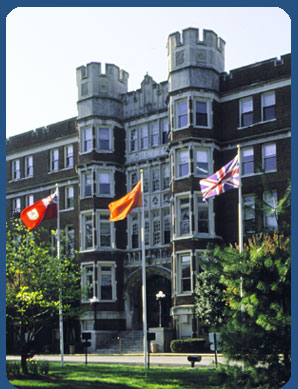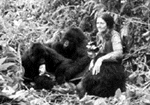| Women's Intellectual Contributions to the Study of Mind and Society Students, as part of an advanced seminar, examined and wrote about the lives of these women,
their intellectual contributions, and the unique impact and special problems that being female had
on their careers. |  |
| For information about referencing this paper - Click Here |
Dr. Dian Fossey (1932-1985)
by Eric W. Codak

Childhood
Dian was a second generation English Immigrant on her father's side.
She lived her younger years in California Her parents separated when
she was at an early age due to her father's heavy drinking and involvement with the law. Dian stayed with her mother who later remarried to a Richard Price. His involvement in Dian's life was unnerving due to his stern traditionalist ideologies.
Her interest for animals were withheld due to house rules. She was permitted once to have a goldfish, but when it died she was not to have any more pets.
College Education
Dian's parents acted and seemed wealthy but still did not help with
her college education. Instead her maternal aunt and uncle helped
with her finances while she attended school.
After she had finished high school in 1949, she attended Marin Junior
College in California. She took business classes encouraged by her
stepfather and hated them. She worked part time at a department store
while she was in school and at one time as a machine operator in a
factory.
When she was 19 the summer after her first year of college she was
offered to be a ranch hand on a dude ranch in Montana. Here she got
completely wrapped up in the animals or anything that walked or flew.
This all came to an abrupt end due to Dian contracting chickenpox and
had to leave early.
In 1950, she went back to school, this time picking her own classes,
and enrolled as a pre- veterinarian medical student at the University
of California at Davis. She liked the courses in biology but had a
hard time dealing with the "hard sciences", like chemistry and physics
and eventually failed out her second year.
In 1952, Dian transferred to San Jose State College, with a new
interest in working with damaged children. She later graduated with a
degree in occupational therapy in 1954.
She would later go back to college to Cambridge University were she
received a Ph. D. in Zoology in 1974 after establishing the Karioke
research Center in Rwanda in 1967.
Life After College
After graduating she interned at various hospitals in California
working with tuberculosis patients for nine months. Wanting to get
away from California she looked for and got a job as far away as she
could, at Kosair Children's Hospital in Louisville, Ky.
She dealt with the fact that she could visit her mother and stepfather
on holidays but other than ritual visits, she did not want to relive
her stay in California. Hired on as the Director of the occupational
therapy department at Kosair, she enjoyed working with the rugged,
friendly backwoods people of Kentucky. She lived outside the city
limits, renting a dilapidated cottage on a farm called, Glenmary. The
owners there encouraged her to pitch in with seasonal work, putting
her veterinarian expertise to use on the farm with the animals.
Influential People
An important person Dian came in contact with was Mary White Henry,
secretary to the chief administrator at Kosair Hospital. Mary
introduced Dian to many of Louisville's society, being that of the
opposite sex.
Still young and in her early twenties, her look was that of a tall
slender built woman, with strong features. Although not
conventionally beautiful she did attract many young men.
One man she met who had become involved with sporadically throughout
Dian's life was, Franz Forester. He was a some what wealthy Rhodesian
who had invoked the closest relationship Dian had yet.
Although Mary had introduced Dian to Franz, she also would unknowingly
involve Dian with yet another man who would unknowingly convert her to
Catholicism. His name was Father Raymond. He was an Irish priest who
she had become involved with over a period of time.
Although her intimate relationship grew with the priest it also did
with Franz Forester. In 1957, he offered her a paid trip to Africa on a one way trip to
live there at his parents estate.
Key Introduction to Gorillas
The seed was planted and although she regretfully denied several
different trips to Africa, one also offered by Mary White in 1960, she
still had a burning desire to go to a place where all the animals
weren't driven into little corners, roaming freely about.
Understanding that financially she could not afford the trip, she
began to accumulate literature on safari's, and was determined to
reach Africa before the year ended in 1963.
By June of that year she had made arrangements to hire a Nairobi
safari guide at the price of Five-thousand dollars. She mortgaged her
income for the next three years from the hospital to a loan company at
an interest of twenty-four percent.
She continued to educate herself with any kind of literature she could
find. One particular book
"The Year of the Gorilla" by zoologist George Schaller, held the
most interest for Dian. This was the start for her desire to learn
more about the rare mountain gorillas which was explained in
Schaller's book.
Packing for her first encounter to Africa, her luggage didn't compare
to the amount of medication she had to bring along. Dian's allergies
were certainly not on the itinerary for the trip, so she suited her
self with all the allergy medicines she could imagine.
First Experience of Africa
After reaching Africa she was led to believe that the renowned
paleoanthropologist, Dr. Louis Leakey was in Nairobi. Her experience
of the Congo was quickly impressionable on Dian and wanted to further
her knowledge of the mountain gorilla and to experience even seeing
one.
After coming in contact with Dr. Leakey, she expressed her interest in
his work and the work of the gorillas as influenced by George
Schaller. Little if not any impressed with her he told her to keep in
touch after her brief visit.
Following the visit, Dian and her guide stopped in the village of
Kisoro and met up with a group of photographers heading up one of the
volcanic mountains, Mt. Mikeno.
This is where Dian saw her first sign of gorilla life of a sleeping
area they had been at the night before. The experience would determine
the future course of her life.
Dr. Louis Leakey & Going back to Africa
After returning to Louisville, Dian had again met up with Dr. Louis
Leakey at a conference and influenced him enough to have him sponsor
her with research support.
She knew she was under qualified with no anthropology, biology,
ethnology, or zoology background, but Dr. Leakey liked Dian's ambition
for the gorillas.
After getting a grant from the Wilkie foundation which supported Jane
Goodall with her efforts in studying chimpanzees, Dian was now headed
to Africa. She was later supported by the National Geographic and
left for Africa after resigning Kosair Children's Hospital in 1966.
Karisoke Research Center
The research center was established in 1967 between two volcanic
mountain ranges, Mt. Karisimbi and Mt. Visoke located in the Parc
des Volcans in Rwanda. The park is located on the border of
Zaire, within 10 miles of Uganda. She later housed her anti-poaching
patrols there as headquarters to stop the slaying of gorillas. The
research center also brought in other scientists to study different
aspects of the gorillas biology.
Accomplished Research
Her pioneering work with the gorillas has forever changed the ways
animals are studied in the wild. Her observations of gorillas
behavior, dispelled myths about the mountain gorillas violence. She
sat unharmed, within a few feet of them almost everyday for 22 years.
She also noted many vocalistics and behavior patterns within their
each family of gorillas she had observed. Dian became very involved
with one particular gorilla, Digit, who was later beheaded by
poachers.
Dian set up the Digit Fund (now the DFGF) to attract international
support for gorilla conservation. (To contact the DFGF see below).
Gorilla Poachers
The poachers were locals making money off of the hands, heads and feet
of the gorillas. The heads were used as wall decorations and hands
and feet as ashtrays. Dian's reputation with the locals was not
always very good. She often played with the notion that they thought
she was a witch (because of local Black Magic beliefs) and played the
role of a witch while interrogating poachers they had caught.
She also was threatened to be kicked out by the government because
she suspected involvement with the poachers and Rwandan government.
She continuously had to legalize her paper and work permits to further
her work.
Unnatural Death
Dian Fossey was murdered by an unknown attacker in her cabin at the
Karisoke Research Center in the Virunga Mountains in 1985. The
attacker hacked her to death by what investigators believe to be a
machete. They entered through a hole in the wall prior to the
attack. No arrests have ever been made, but local authorities believe
it to be poachers who were at odds with Dian and her anti-poaching
brigade of but a few soldiers.
Bibliography & Links to learn more
-
http://www.netsrq.com/~dbois/fossey.html
- Discover Magazine, Feb 1987 v.8 p.28(14)
- Fossey, D. Gorillas in the Mist. Boston: Houghton Mifflin, 1983.
- Mowat, F. Woman in the Mists. New York: Warner Books, c1987.
- People Weekly, Feb 17, 1986 v.25 p.46(5)
- Time Magazine, Jan 13, 1986 v.127 p.38(1)
The Dian Fossey Gorilla Fund (DFGF)
For more information and pledges for support contact:
The Dian Fossey Gorilla Fund UK, 110 Gloucester Avenue, London NW1
8JA
Tel: 0171-483 2681 Fax: 0171-483 4541 (International: 44-171-483
2681)
Reg. Charity No: 801160
Back to Women's Page

